Thirty years ago this week, an 11-year-old girl travelled from home in Bedford to watch her father run the London Marathon.
As she waited, someone else caught her eye: the Norwegian runner Ingrid Kristiansen scything through the mostly male athletes to smash the women’s world marathon record in a time of two hours, 21 minutes and six seconds. “It broke down any barriers I had in my head,” says Paula Radcliffe. “I thought: why can’t I be in there running and being competitive too?”
That day at the marathon changed her. Years later, she would change the marathon. Her world record of two hours, 15 minutes and 25 seconds, set in London in 2003, is more than three minutes quicker than that of any other woman. Her friend Jo Pavey, who won the European 10,000m title aged 40 last year, calls the record “unbelievable and almost unbeatable. To run 26.2 miles at just over five minutes a mile pace is staggering”.
Dave Bedford, the race director that year, recalls his disbelief at the time. “I started to panic because we thought there was something wrong with our timing system,” he says.
At 41, Radcliffe will end her competitive career in the London Marathon on Sunday. Irreversible injury to her left foot means she cannot keep up with the elite field. So she will tootle along with the club runners, like her father Peter did, watched by her eight-year-old daughter, Isla, four-year-old son, Raphael, and husband and coach, Gary Lough.
Her running life has come full circle.
Radcliffe’s life in running, though, shows no sign of stopping. She works on the BBC’s athletics coverage and mentors young endurance athletes. She has a degree in modern European studies, with fluent French and German. Many tip her for a senior role within the IAAF, athletics’ governing body.
Sebastian Coe, a former 800m world record holder, says that while Radcliffe’s athletic achievements are “seismic”, her influence on wider society is as least as great. “She gave women permission to feel they could go out and run and be part of the London Marathon,” he says. “A generation of runners, male and female, have taken up the sport because of Paula Radcliffe.”
Hugh Brasher, the London Marathon’s elite director, cites “the Paula effect”. “After her world record, you could hardly buy a pair of women’s running shoes because most shops had sold out,” he says. “Paula made something that was slightly eccentric for women to do entirely normal.”
What made her so special? Not only genes and a Stakhanovite zeal for work, but a staggering tolerance of pain.
Physiotherapist Gerard Hartmann, who has worked with 73 Olympic medal winners, says only Keith Wood, the Irish rugby union player, could take more pain on the massage table than Radcliffe. Sports scientist Andrew Jones recalls that Radcliffe would prefer to fall off the back in exhaustion during treadmill tests rather than tell him to stop the machine.
She was also blessed with something every great endurance athlete needs: a huge engine. Tested at 17 by Jones, her VO2 max – the maximum volume of oxygen an athlete can use – was 70, higher than that of any female athlete in the scientific literature.
“For someone who was so young and wasn’t doing much training at the time, it suggested a lot of potential,” says Jones.” I told her she would take some stopping at the world junior cross-country championships a year later, in 1992, and while she shocked many by winning, I wasn’t surprised.”
Her drive was legendary. She would regularly run 140 to 150 miles a week. Typically, she would run for two or three hours in the morning, followed by two hours of massage or physiotherapy. She would then sleep for up to two hours before a late afternoon run, again followed by massage, strengthening exercises and ice baths for recovery.
“People look at the blond girl from the outside and think butter wouldn’t melt in her mouth,” says Hartmann. “But beneath it all she was the hardest, toughest athlete I ever met. Somewhere she got this desire to be better than great.”
Yet for many years she was the nearly girl of British sport. As a 22-year-old she finished fifth in the 5,000m Atlanta Olympics. In the 10,000m in Sydney, four years later, she was fourth. In the 2001 world championships she was fourth again and left in tears after a row with her husband. There were medals – including silver at the 1999 world championships – but her races followed a pattern. She would lead from the front before losing in a sprint finish.
In 2000, she realised that hard running was not enough. After Sydney, she started working with Hartmann, who began by getting her to do a simple test: hopping 20 times on and off a 40cm box. Kelly Holmes, who won 800m and 1500m gold in Athens in 2004, could do it in 12 seconds, but Radcliffe took 27 because her core and posture were weak. Hartmann introduced plyometrics and heavy weights and, after 18 months, her body no longer tailed off at the end of races. She had become nearly unbeatable.
During her golden period, which lasted until 2008, Radcliffe broke the world marathon record twice and won seven big city marathons and World Championship gold. She also won the world cross-country twice and the world half-marathon championship three times. There were gold medals on the track in the Commonwealth Games and European Championships, too.
One thing eluded her: an Olympic medal. In 2004, in Greece, she was overwhelming favourite for the women’s marathon and, three weeks beforehand, was in the shape of her life. Then came a freak accident: she was running along the trails when a joyrider, going too fast, skidded down near her, sending a sharp stone flying into a knee.
“A stone, like a bullet, had hit the side of her knee and it had turned black,” Hartmann says. “She had a clot and abscess. The UK Athletics doctors injected cortisone a few times and gave her a lot of anti-inflammatories but she wasn’t able to run for two and a half weeks. It was only on the Thursday before the race that Paula, Gary and I went for a 35-minute run around the Athletes’ Village and she decided to run. But nobody except a few people within her inner sanctum knew what was going on.”
In the final few days before the race, her bowel movements were white. Anti-inflammatories were not allowing her to metabolise food properly and she was dehydrated. But Radcliffe, whose best time was several minutes faster than her rivals’, hoped iron will could force her body to defy injury and the 35C heat. That hope was banished after 22 miles when she stopped on the road outside Athens, sat down and started to cry.
The British press, unaware of her problems, branded her a choker. Some of that reputation has stuck – unfairly – because Radcliffe never revealed the extent of her problems, even shunning the ghostwriter of her autobiography, David Walsh, after Athens.
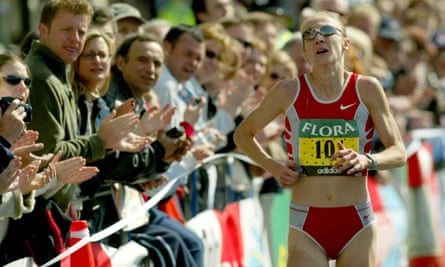
In 2008, there were more tears as she finished 23rd in the Olympic marathon in Beijing. Again, the keyboard warriors accused her of being weak. But she had been hiding a stress fracture of the femur, the long bone of her thigh. She had not run for 12 weeks and only started jogging 16 days before the Games.
When at the finish she hugged Liz Yelling, behind her in 26th, tears again flowed. “We knew the disappointment each of us was facing,” says Yelling. “It’s a hard old game, running for 20 years, twice a day and seeing your dreams die.”
Barry Fudge, the head of endurance for British Athletics, insists Radcliffe is the most successful female distance runner ever. “It is actually very hard to be the best on cross, road and track,” he says. “The mechanisms involved are actually quite different. To be successful in all three is actually very unique.
“Her world record time is also absolutely stunning. To put it into perspective, the qualifying time for the Rio men’s marathon is 2 hours 17 minutes. It will take an exceptional athlete to top what Paula has done.”
Radcliffe has always pushed her body to the limit, but for the past few years it has repeatedly rebelled. After pulling out of the London Olympics, she had an operation on her foot that left her unable to walk. She has dragged herself back for one last attempt at the London marathon, although – inevitably - injury struck again in the build-up.
In the latter part of her career, Radcliffe has been able to juggle training with family life. Fudge says he is impressed by how she and Gary switch from ordinary parents to professional coach-and-athlete and back again.
And while Radcliffe will miss the buzz of competing, she is looking forward to spending more time with her two children in Monaco. Isla is said to be a talented gymnast. “Last week she asked me what will the difference be now I’m not competing seriously any more?” said Radcliffe this week, her voice welling up. “I told her I won’t have to train again after you have come home from school.”
She knows some people will expect the Radcliffe of old, foraging out in front, but for her the race will be about memories, not times. At least 750,000 people are expected to give her a three-hour send-off. Perhaps the next Paula Radcliffe will be watching too?
Potted profile
Born 17 December 1973
Career Radcliffe took up running aged seven, despite suffering from exercise-induced asthma. Her breakthrough came at the 2002 Commonwealth Games in Manchester when she won 5,000m gold
High point Setting her still-unbeaten world record time of 2hr 15min 25sec at the 2003 London Marathon, one of three titles she won in the capital; also her marathon gold medal at the 2005 World Championships in Helsinki
Low point Missing out on the Olympic medal she so craved, most memorably in 2004 when, as the overwhelming favourite, she pulled up by an Athens roadside in tears with four miles to go
She says “Life has to have the ups and downs – it would be boring if it didn’t”
They say “She went to Mars and beyond. She set a [world] record that’s so far out there, it could become 25 years old. That tells you everything” – Gerard Hartmann, physiotherapist

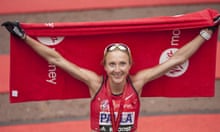
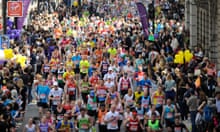

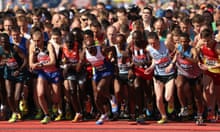
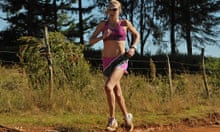


Comments (…)
Sign in or create your Guardian account to join the discussion